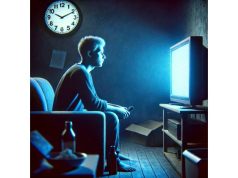
A summer glow can feel like confidence bottled into skin, yet for some people the urge to tan mutates into an unshakable compulsion. They chase ultraviolet rays—sun, beds, or lamps—despite burns, wrinkles, and warnings about melanoma. This behavior, nicknamed “tanorexia,” blends body-image pressure, biochemical reward, and social cues, making it surprisingly tough to quit. In this deep-dive guide you’ll learn how tanning dependence develops, who is most vulnerable, and the practical, science-backed steps that lead to healthier skin and a healthier relationship with the sun.
Table of Contents
- Cultural Context and How Common It Really Is
- Underlying Biology, Psychology, and Situational Triggers
- Key Warning Cues, Symptom Patterns, and How Professionals Identify It
- Body, Mind, and Relationship Repercussions
- Proven Interventions, Support Networks, and Maintenance Plans
- Frequently Asked Questions
Cultural Context and How Common It Really Is
The drive to darken skin may feel new, but the social meaning attached to tan skin has bounced across centuries. In Victorian England pale complexions signaled leisure; by the 1920s Coco Chanel’s Riviera glow flipped the script, and bronzed skin started representing freedom, wealth, and vitality. Fast-forward to today and sun-kissed selfies flood social feeds every spring break, reinforcing the idea that “healthy” equals “tan.” Add filters that warm undertones and suddenly natural complexions look dull by comparison.
Global Usage Patterns
- Indoor tanning industry: At its peak in the early 2010s, the United States housed over 25,000 salons—more than Starbucks outlets. Numbers have fallen under tighter laws, yet 7–10 million Americans still tan indoors annually.
- Age trends: Surveys reveal that 15–20 % of U.S. high-school girls and 30 % of college women report indoor tanning within the past year. Men tan too, especially bodybuilders and individuals in appearance-focused sports, but they under-report due to stigma.
- Regional spikes: Australia’s harsh sun originally fueled tanning culture; now, strict regulations and stark melanoma campaigns have slashed salon prevalence by 80 %. Northern Europe, where winter lasts months, shows rising demand for light therapy pods that sometimes double as tanning booths.
- Mobile UV devices: Portable facial lamps, marketed as “vitamin D boosters,” are gaining traction online, bypassing salon regulations and complicating prevalence estimates.
Socioeconomic and Demographic Nuances
| Demographic Slice | Typical Motivation | Relative Risk |
|---|---|---|
| White, middle-class teens | Conformity with peer beauty ideals | High |
| LGBTQ+ communities | Pursuit of hyper-aesthetic body standards | Moderate–High |
| Individuals with seasonal affective disorder (SAD) | Mood lift through UV exposure | Moderate |
| Bodybuilding circuit | Stage color for muscle definition | Moderate |
| Outdoor laborers | Occupational exposure plus social acceptance | Variable |
Why Prevalence Numbers Matter
The more normalized a behavior, the harder it becomes to spot addiction within it. When half a dorm heads to the tanning salon, escalation looks like enthusiasm rather than a warning sign. Recognizing community norms—and how marketing capitalizes on them—prepares you to challenge unhealthy expectations.
Underlying Biology, Psychology, and Situational Triggers
Tanning addiction rarely stems from vanity alone. It is a braid of neurochemistry, emotional regulation, and environmental reinforcement.
Biological Hooks
- β-Endorphin release
Ultraviolet radiation stimulates keratinocytes to produce pro-opiomelanocortin, which splits into β-endorphins—natural opioids that generate mild euphoria and pain relief. Frequent tanners may therefore feel irritable or low when UV exposure drops, mirroring opioid withdrawal. - Dopamine reward loop
The brain’s mesolimbic pathway logs each tanning session as a “win.” Over time, it takes longer or more intense sessions to achieve the same dopamine spike, nudging users toward compulsion. - Circadian modulation
UV light, especially in morning hours, suppresses melatonin and elevates serotonin. For people battling seasonal affective disorder, the mood bump can rival antidepressants, reinforcing frequent exposure.
Psychological Drivers
- Body-image schema: Western culture often equates a bronze tone with fitness, attractiveness, and even social status. Internalization of these standards magnifies fear of looking “pale” or “sick.”
- Anxiety coping mechanism: Warmth, solitude, and the rhythmic hum of tanning beds mimic sensory-soothing environments, making sessions a self-medication ritual during stress.
- Perfectionistic tendencies: Individuals who set extreme appearance goals may use tanning as one of several control behaviors, alongside rigid dieting or cosmetic procedures.
Situational Catalysts
| Trigger | How It Fuels Behavior | Real-Life Example |
|---|---|---|
| Special events | Desire to look “photo-ready” | Bride books unlimited tanning pass before wedding |
| Climate | Long winters increase UV cravings | College students in Michigan buy monthly salon packages |
| Peer offers | Friends share discount codes | “Two-for-one Tuesdays” group outings |
| Athletic competitions | Judges favor darker skin definition | Figure-skating team rents tanning booth backstage |
Genetic Susceptibility
Variants in the MC1R gene, linked to red hair and fair skin, may heighten endorphin response to UV, ironically making those most prone to burns also most at risk for dependence. Family history of addictive behaviors further amplifies likelihood of tanning compulsion.
Action tip: Identify which triggers resonate with your routine. Awareness is the first lever for change—a mental note each time you feel the pull can interrupt automatic habit loops.
Key Warning Cues, Symptom Patterns, and How Professionals Identify It
Not every beach lover is addicted. The line is crossed when pursuit of a tan undermines health, relationships, or daily functioning—and when attempts to stop provoke distress.
Behavioral Indicators
- Escalating frequency: What started as a pre-holiday glow becomes four salon visits a week, plus outdoor sunbathing.
- Time theft: Hours arranging appointments, driving to salons, or researching UV lamps eat into work and social life.
- Perceived paleness distortion: Looking in the mirror, the person feels “ghostly” even while others comment on deep coloration.
- Disregard for harm: Continuing to tan despite blistering burns, dermatologist warnings, or a relative’s melanoma diagnosis.
- Craving and agitation: Restlessness or bad mood if weather is cloudy or salons are closed.
Physical and Emotional Symptoms
- Skin signs: Peeling, itchiness, premature wrinkles, “leathery” texture.
- Immune changes: Frequent cold sores or infections, hinting at UV-related immunosuppression.
- Mood fluctuations: Short-lived euphoria post-tan followed by slumps, mirroring substance highs and crashes.
- Sleep shifts: Evening bed use can delay melatonin onset, causing insomnia.
Self-Assessment Checklist
Answer yes or no:
- I feel anxious when I skip a scheduled tanning session.
- Friends have expressed worry about how dark my skin looks.
- I hide how often I tan or downplay session length.
- I tan to change a bad mood rather than to look better.
- I have continued tanning after my doctor advised me to stop.
Three or more yes answers suggest you might be dealing with tanning addiction.
Clinical Evaluation Path
- History intake: Frequency, duration, type (sun vs. bed vs. lamp), sunscreen use, skin-cancer screenings.
- Dermatologic exam: Mapping moles, checking for actinic keratosis, baseline photography for comparison.
- Psychological screening: Body-dysmorphic disorder scales, anxiety inventories, and addiction assessment tools like the Structured Interview for Tanning Abuse and Dependence (SITAD).
- Laboratory tests: Vitamin D levels (to address perceived “deficiency” arguments), and in rare cases, β-endorphin levels in research settings.
- Diagnostic impression: Although “tanorexia” isn’t a DSM-5 diagnosis, clinicians may code it under “other specified obsessive-compulsive and related disorder” or note it as a behavioral addiction.
Professional insight: Include partners or friends in the interview when possible; collateral reports often reveal tanning frequency the patient underestimates.
Body, Mind, and Relationship Repercussions
The costs of chronic UV exposure stretch far beyond sunburn.
Dermatologic Damage
- Photoaging – Collagen fibers break down, producing fine lines, enlarged pores, and mottled pigmentation years earlier than genetically predicted.
- Hyperpigmentation hotspots – Freckles and sunspots cluster on shoulders, chest, and face, creating uneven tone that tanning paradoxically intensifies.
- DNA mutation cascade – UVB rays generate thymine dimers; over time, repair mechanisms falter, seeding basal-cell and squamous-cell carcinomas, plus the deadlier melanoma.
Systemic Health Hazards
| System | Potential Consequence | Mechanism |
|---|---|---|
| Ocular | Cataracts, pterygium growth | UV penetrates cornea and lens |
| Immune | Lowered response to viral infections | UV-induced cytokine shift |
| Endocrine | Hormonal imbalance via pituitary suppression | Excessive β-endorphin feedback |
| Reproductive | Fetal risks in pregnant tanners | Heat stress, folate degradation |
Psychological Fallout
- Anxiety spiral: Reliance on tanning for mood regulation can entrench generalized anxiety when sessions are missed.
- Perfectionism overload: Chasing an ever-darker shade parallels eating-disorder patterns where goals move perpetually out of reach.
- Social isolation: Friends tire of beach-centric plans or salon detours, eroding relationships.
Financial and Occupational Strain
- Cost tally: Unlimited monthly passes (\$40–\$80) add up, plus aftercare creams, dermatologist copays, and eventually cosmetic procedures such as laser spot removal.
- Workplace impact: Time spent tanning during lunch breaks leads to missed meetings; visible burns may conflict with professional dress codes.
Bottom line: Short-term bronzing can translate into long-term medical debt, career setbacks, and psychological distress—far beyond mere sunspots.
Proven Interventions, Support Networks, and Maintenance Plans
Kicking a tanning habit calls for both skin-centric strategies and addiction-informed care.
1. Medical Skin Protection Protocol
- Dermatology partnership: Schedule full-body exams at least annually—or every six months if you have a history of severe sunburns. Mole-mapping apps can track changes between visits.
- Barrier arsenal: Broad-spectrum SPF 30+ every morning, UV-blocking clothing, polarized sunglasses, and wide-brimmed hats.
- Repair agents: Topical retinoids, vitamin C serums, and peptides support collagen production, helping visible recovery reinforce abstinence motivation.
2. Behavioral and Cognitive Therapies
| Modality | Targeted Benefit | Ideal Candidate |
|---|---|---|
| Cognitive Behavioral Therapy (CBT) | Challenge distorted “paleness” beliefs, build alternative coping skills | Most individuals |
| Motivational Interviewing (MI) | Resolve ambivalence, enhance intrinsic reasons to quit | Early-stage contemplators |
| Exposure and Response Prevention (ERP) | Gradually reduce tanning sessions while tolerating anxiety | Severe habit strength |
| Body-Image Workshops | Promote appearance diversity acceptance | Those with perfectionism traits |
3. Pharmacologic Aids (Adjunctive)
- Naltrexone (25–50 mg daily): An opioid-receptor antagonist shown in small studies to blunt UV-triggered β-endorphin reward, reducing cravings.
- Selective serotonin reuptake inhibitors (SSRIs): Helpful when underlying anxiety or OCD features drive tanning.
- Melanotan cessation: Some users inject illegal “barbie peptides.” Endocrinologists monitor thyroid and insulin resistance during detox.
4. Safe Aesthetic Alternatives
- DHA sunless sprays or lotions – Provide color without UV; pair with exfoliation for even tone.
- Tinted moisturizers – Build gradual glow; easier to control depth and maintain.
- Bronzing makeup – Short-term option for special events, washing off the next day.
5. Support Ecosystem
- Peer groups: Online forums (e.g., “Tanning Addiction Recovery” Facebook group) share progress pics and accountability check-ins.
- Influencer partnerships: Follow dermatologists and body-positivity advocates on social media to counteract tanning-centric feeds.
- Family contracts: Written agreements about limiting salon budgets or setting sunscreen reminders build external accountability.
6. Maintenance Blueprint
- Relapse plan: Identify early warning signs—dreaming about tanning beds or obsessively weather-app checking—then activate coping steps such as texting a friend or booking a spa facial instead.
- Mood management toolkit: Light-therapy boxes (10,000 lux, UV-free) for winter blues, yoga for stress, and creative hobbies to replace tanning time.
- Milestone celebrations: Reward stretch-goals (e.g., six UV-free months) with non-sun gifts—concert tickets, weekend trips somewhere snowy, or a new novel series.
Success snapshot: A 32-year-old salon manager replaced daily bed use with gradual self-tanner, weekly CBT, and a cycling club for endorphin output. One year later, she sports a natural complexion, lower anxiety scores, and a clean dermatology file.
Frequently Asked Questions
Is tanning addiction officially recognized as a medical disorder?
Not yet. While “tanorexia” isn’t in the DSM-5, many dermatologists and psychologists view compulsive tanning as a behavioral addiction similar to gambling or internet overuse.
Can I get enough vitamin D without tanning beds?
Yes. Ten to fifteen minutes of midday sun on arms and legs in summer plus dietary sources or supplements usually maintain adequate levels without high skin-cancer risk.
Do spray tans damage the skin?
Most contain dihydroxyacetone (DHA), approved for external use. When applied correctly, they’re far safer than UV exposure, though people with eczema should patch-test to avoid irritation.
How long does it take for my natural skin tone to return?
Superficial tanning fades as epidermal cells shed—about two to four weeks. Deep dermal pigmentation can linger months, especially if tanning was chronic.
Does quitting tanning cause withdrawal symptoms?
Some users experience restlessness, mood dips, or cravings for warmth and light, typically resolving within two weeks as β-endorphin cycles normalize.
Are red-light therapy beds a safe alternative?
Red-light wavelengths (630–660 nm) don’t tan skin and may aid collagen, but some hybrid beds mix red and UV. Verify specs and still prioritize SPF for outdoor exposure.
Disclaimer
This content is intended for educational purposes only and does not replace personalized medical advice. Always consult qualified healthcare professionals before making decisions about UV exposure, supplements, or mental-health treatment.
If this article helped you, please share it on Facebook, X (formerly Twitter), or any platform you love, and follow us for more science-backed wellness insights. Your support lets us keep creating high-quality resources—thank you!










